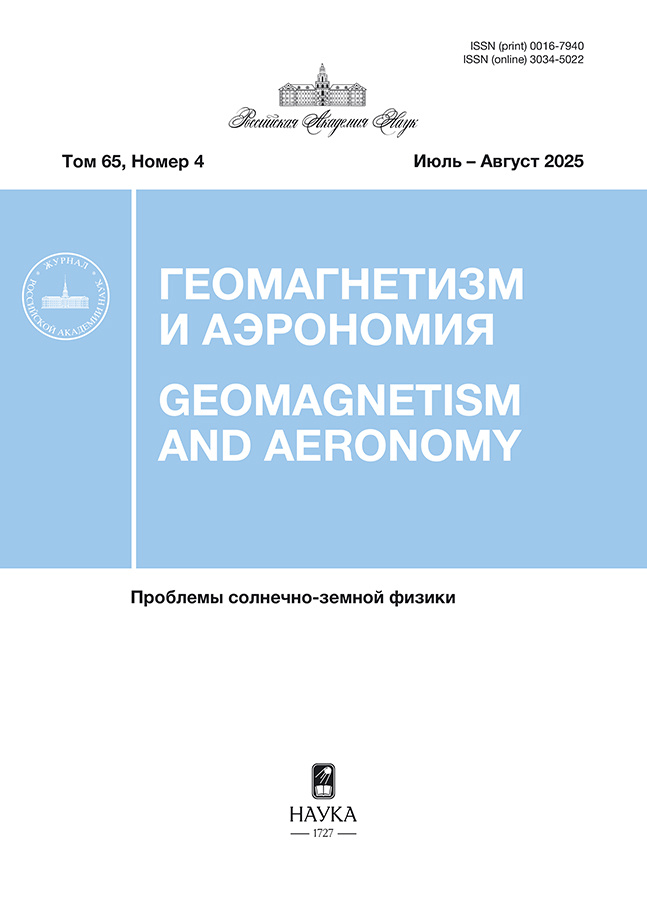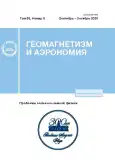Properties of the Variability of the Maximum Density of the F2-Layer over Almaty at Different Levels of Solar and Geomagnetic Activity
- Authors: Deminov M.G.1, Deminova G.F.1, Depuev V.K.1, Depueva A.K.1
-
Affiliations:
- Pushkov Institute of Terrestrial Magnetism, Ionosphere and Radio Wave Propagation, Russian Academy of Sciences (IZMIRAN)
- Issue: Vol 63, No 5 (2023)
- Pages: 630-637
- Section: Articles
- URL: https://gynecology.orscience.ru/0016-7940/article/view/650988
- DOI: https://doi.org/10.31857/S0016794023600308
- EDN: https://elibrary.ru/UBNRBU
- ID: 650988
Cite item
Abstract
The properties of the variability of the maximum density of the F2-layer Nm at different levels of
solar and geomagnetic activity have been analyzed based on hourly data of the Almaty station (43.2° N, 104° E)
for 1958–1988. The standard deviation σ(x) of the fluctuations of Nm relative to the quiet level
(x = (Nm/Nm0 – 1) × 100, %) and the average shift of these fluctuations xave are used to characterize this
variability. In this path, an empirical model of the F2-layer maximum density Nm0 for low geomagnetic activity
has been created. It has been found that the variability of Nm depends weakly on the level of solar activity.
The dependence of the variability of Nm on geomagnetic activity is one of the main ones, along with the
dependences of this variability on time of day and season. In general, the variance σ2(x) is smaller for quiet
conditions than for periods of high geomagnetic activity. However, during periods of high geomagnetic activity,
a further increase in geomagnetic activity does not lead to an increase in the variance σ2(x). The saturation
in the increase in the variance σ2(x) against the background of a continuing increase in geomagnetic activity
and the absence of this saturation for the average shift xave seems to be a stable property of the variability of
the mid-latitude ionosphere during periods of geomagnetic storms. This conclusion is based on an additional
analysis of ionospheric variability according to data from the Irkutsk and Yamagawa stations, which are
located about 10 degrees north and south of Almaty station, respectively.
About the authors
M. G. Deminov
Pushkov Institute of Terrestrial Magnetism, Ionosphere and Radio Wave Propagation, Russian Academy of Sciences(IZMIRAN)
Email: deminov@izmiran.ru
Moscow, Russia
G. F. Deminova
Pushkov Institute of Terrestrial Magnetism, Ionosphere and Radio Wave Propagation, Russian Academy of Sciences(IZMIRAN)
Email: deminov@izmiran.ru
Moscow, Russia
V. Kh. Depuev
Pushkov Institute of Terrestrial Magnetism, Ionosphere and Radio Wave Propagation, Russian Academy of Sciences(IZMIRAN)
Email: deminov@izmiran.ru
Moscow, Russia
A. Kh. Depueva
Pushkov Institute of Terrestrial Magnetism, Ionosphere and Radio Wave Propagation, Russian Academy of Sciences(IZMIRAN)
Author for correspondence.
Email: deminov@izmiran.ru
Moscow, Russia
References
- – Деминов М.Г. Жеребцов Г.А., Пирог О.М., Шубин В.Н. Регулярные изменения критической частоты F2-слоя спокойной ионосферы средних широт // Геомагнетизм и аэрономия. Т. 49. № 3. С. 393–399. 2009.
- – Деминов М.Г., Деминова Г.Ф., Жеребцов Г.А., Полех Н.М. Свойства изменчивости концентрации максимума F2-слоя над Иркутском при разных уровнях солнечной и геомагнитной активности // Солнечно-земная физика. Т. 1. № 1. С. 56–62. 2015. https://doi.org/10.12737/6558
- – Altadill D. Time/altitude electron density variability above Ebro, Spain // Adv. Space Res. V. 39. № 5. P. 962–969. 2007. https://doi.org/10.1016/j.asr.2006.05.031
- – Araujo-Pradere E.A., Fuller-Rowell T.J., Codrescu M.V. STORM: An empirical storm-time ionospheric correction model, 1, Model description // Radio Sci. V. 37. № 5. 1070. 2002. https://doi.org/10.1029/2001RS002467
- – Araujo-Pradere E.A., Fuller-Rowell T.J., Codrescu M.V., Bilitza D. Characteristics of the ionospheric variability as a function of season, latitude, local time, and geomagnetic activity // Radio Sci. V. 40. № 5. RS5009. 2005. https://doi.org/10.1029/2004RS003179
- – Bilitza D. IRI the international standard for the ionosphere // Adv. Radio Sci. V. 16. P. 1–11. 2018. https://doi.org/10.5194/ars-16-1-2018
- – Buonsanto M.J. Ionospheric storms: a review // Space. Sci. Rev. V. 88. № 3–4. P. 563–601. 1999. https://doi.org/10.1023/A:1005107532631
- – Deminov M.G., Deminova G.F., Zherebtsov G.A., Polekh N.M. Statistical properties of variability of the quiet ionosphere F2-layer maximum parameters over Irkutsk under low solar activity // Adv. Space Res. V. 51. № 5. P. 702–711. 2013. https://doi.org/10.1016/j.asr.2012.09.037
- – Forbes J.M., Palo S.E., Zhang X. Variability of the ionosphere // J. Atmos. Sol.-Terr. Phy. V. 62. № 8. P. 685–693. 2000. https://doi.org/10.1016/S1364-6826(00)00029-8
- – Fotiadis D.N., Kouris S.S. A functional dependence of foF2 variability on latitude // Adv. Space Res. V. 37. № 5. P. 1023–1028. 2006. https://doi.org/10.1016/j.asr.2005.02.054
- – Lei J., Liu L., Wan W., Zhang S.-R. Variations of electron density based on long-term incoherent scatter radar and ionosonde measurements over Millstone Hill // Radio Sci. V. 40. № 2. RS2008 2005. https://doi.org/10.1029/2004RS003106
- – Liu L., Wan W., Ning B., Pirog O.M., Kurkin V.I. Solar activity variations of the ionospheric peak electron density // J. Geophys. Res. – Space. V. 111. № 8. A08304. 2006. https://doi.org/10.1029/2006JA011598
- – Ma R., Xu J., Wang W., Yuan W. Seasonal and latitudinal differences of the saturation effect between ionospheric NmF2 and solar activity indices // J. Geophys. Res. – Space. V. 114. № 10. A10303. 2009. https://doi.org/10.1029/2009JA014353
- – Pavlov A.V., Pavlova N.M., Makarenko S.F. A statistical study of the mid-latitude NmF2 winter anomaly // Adv. Space Res. V. 45. № 3. 374–385. 2010. https://doi.org/10.1016/j.asr.2009.09.003
- – Pirog O., Deminov M., Deminova G., Zherebtsov G., Polekh N. Peculiarities of the nighttime winter foF2 increase over Irkutsk // Adv. Space Res. V. 47. № 6. P. 921–929. 2011. https://doi.org/10.1016/j.asr.2010.11.015
- – Ratovsky K.G., Medvedev A.V., Tolstikov M.V. Diurnal, seasonal and solar activity pattern of ionospheric variability from Irkutsk Digisonde data // Adv. Space Res. V. 55. № 8. P. 2041–2047. 2015. https://doi.org/10.1016/j.asr.2014.08.001
- – Ratovsky K.G., Medvedeva I.V. Local empirical model of ionospheric variability // Adv. Space Res. V. 71. № 5. P. 2299–2306. 2023. https://doi.org/10.1016/j.asr.2022.10.065
- – Richards P.G., Fennelly J.A., Torr D.G. EUVAC: A solar EUV flux model for aeronomic calculations // J. Geophys. Res. – Space. V. 99. № 5. P. 8981–8992. 1994. https://doi.org/10.1029/94JA00518
- – Richards P.G., Woods T.N., Peterson W.K. HEUVAC: A new high resolution solar EUV proxy model // Adv. Space Res. V. 37. № 2. P. 315–322. 2006. https://doi.org/10.1016/j.asr.2005.06.031
- – Rishbeth H., Mendillo M. Patterns of F2-layer variability // J. Atmos. Sol.-Terr. Phy. V. 63. N 15. P. 1661–1680. 2001. https://doi.org/10.1016/S1364-6826(01)00036-0
- – Taylor J.R. An introduction to error analysis. – Mill Valley, CA: Univer. Sci. Books, 270 p. 1982.
- – Wrenn G.L. Time-weighted accumulations ap(τ) and Kp(τ) // J. Geophys. Res. – Space. V. 92. № 9. P. 10 125–10 129. 1987. https://doi.org/10.1029/JA092iA09p10125
- – Wrenn G.L., Rodger A.S. Geomagnetic modification of the mid-latitude ionosphere – Toward a strategy for the improved forecasting of foF2 // Radio Sci. V. 24. № 1. P. 99–111. 1989. https://doi.org/10.1029/RS024i001p00099
- – Zhang S.-R., Holt J.M. Ionospheric climatology and variability from long-term and multiple incoherent scatter radar observations: variability // Ann. Geophys. V. 26. № 6. P. 1525–1537. 2008. https://doi.org/10.5194/angeo-26-1525-2008
Supplementary files









